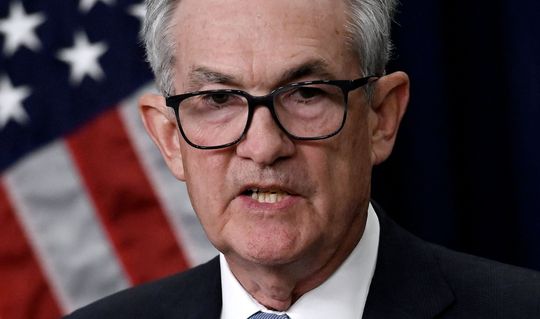Dow, S&P 500 end at lowest since December 2020
U.S. stocks closed sharply lower Thursday, more than erasing the bounce seen the previous session following the Federal Reserve’s largest rate hike since 1994, as worries about the economic outlook moved center stage.
What happened
- The Dow Jones Industrial Average DJIA dropped 741.46 points, or 2.4%, ending at 29,927.07.
- The S&P 500 SPX shed 123.22 points, or 3.3%, closing at 3,666.77.
- The Nasdaq Composite COMP declined 453.06 points, or 4.1%, finishing at 10,646.10.
- The Dow and S&P 500 booked their lowest closes since December 2020; the Nasdaq ended at its lowest since September 2020, according to Dow Jones Market Data.
On Wednesday, the Dow rose 304 points, or 1%, while the S&P 500 gained 1.5% as the indexes snapped a bruising five-day losing streak. The Nasdaq Composite ended with a gain of 2.5%.
What drove markets
The Fed’s three-quarters of a percentage point interest rate hike on Wednesday could be followed by another hike of that magnitude in July, or a half-point increase, according to Fed Chair Jerome Powell at a press conference after the decision was announced. The Fed also cut its economic growth forecast and lifted its unemployment outlook, while not going as far as to predict recession.
“It’s quite disheartening,” said John Carey, director of equity income at Amundi US, by phone. “People are now openly talking about the possibility of a recession, in part, because of the dampening effect of higher rates needed to bring inflation under control.”
The spark of hopefulness on display Wednesday post-Fed decision has given way to a sense of dread, he said, as investors mull the likelihood that the economy slows and corporate earnings come under pressure from higher costs and climbing rates.
“I feel bad for a lot of people who have retirement savings at risk,” Carey said.
“Markets now expect the Fed to tighten more aggressively than previously laid out,” said Ross Mayfield, investment strategy analyst at Baird Private Wealth Management, in a note. “Higher interest rates mean a cooler U.S. economy, and therefore a higher chance of recession in the next couple of years. Market selloffs have historically been deeper and longer when associated with a recession, helping explain the downside volatility of the last few days.”
Analysts also drew attention to the fact that not only did Powell express concern about last week’s data showing U.S. consumer prices shooting up by 8.6% in the 12 months ending May, but he also noted rising inflation expectations, as measured by the University of Michigan’s consumer sentiment report.
While stimulus initially helped fuel spending, “inflation has shifted to a more permanent — and more threatening — trend, driven by housing and services,” Brad McMillan, chief investment officer at Commonwealth Financial Network, said in a client note. “That has made it a much higher risk than it appeared even a month or two ago.”
Treasury yields fell Thursday as the selloff in equities appeared to spark haven-buying interest. The yield on the 10-year Treasury note BX:TMUBMUSD10Y was down 8.6 basis points at 3.303%.
Meanwhile, the Swiss National Bank delivered a surprisingly large half-point rate hike Thursday, which buoyed the Swiss franc USDCHF, while the Bank of England lifted rates by a quarter-point, with the central bank’s relatively cautious guidance sending the pound lower.
In U.S. economic data, construction started on new U.S. homes fell 14.4% in May, the Commerce Department said Thursday. The annual rate of total housing starts fell to 1.55 million last month from a revised 1.81 million in April. Economists polled by The Wall Street Journal expected housing starts to fall to a 1.68 million rate from April’s initial estimate of 1.72 million.
The Federal Reserve Bank of Philadelphia said Thursday that its gauge of regional business activity fell to -3.3 in June from 2.6 in the prior month, signaling the first contraction in factory activity since May 2020.
New filings for unemployment benefits fell by 3,000 last week to 229,000, but they remained close to a five-month high, possibly offering a sign that layoffs have ticked up from record-low levels.
Companies in focus
- Revlon Inc. REV said Thursday that it has voluntarily filed for bankruptcy. Shares fell 13.3%.
- Tesla Inc. TSLA is hiking its U.S. prices, as the electric vehicle maker battles rising aluminum costs and the global supply chain crisis. Shares lost 8.5%.
Other assets
- The ICE U.S. Dollar Index DXY, a measure of the currency against a basket of six major rivals, fell 1.4%.
- Bitcoin BTCUSD fell another 3.3% to trade near $20,900.
- Oil futures were choppy, with the U.S. benchmark CL ending 2% higher at $117.58 a barrel. Gold futures GC00 rose 1.7% to settle at $1,849.90 an ounce.
- The Stoxx Europe 600 XX:SXXP dropped 2.5%, while London’s FTSE 100 UK:UKX tumbled 3.1%.
- The Shanghai Composite CN:SHCOMP ended 0.6% lower, while the Hang Seng Index HK:HSI dropped 2.2% and the Japan’s Nikkei 225 JP:NIK rose 0.4%.

